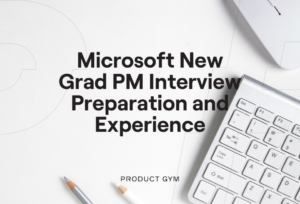Are you still trying the “wing it” approach in your interviews? Behavioral interview questions are fundamental to the Product Manager interview process, but they can quickly become messy if you don’t prepare for them in advance.
Behavioral interview questions tend to take a situation or scenario and ask you to share your approach to addressing it. You can also expect that at least one of these questions will be based on solving some form of conflict.
Because behavioral questions are rooted in your own experience, you’re going to find yourself self-disclosing errors that you’ve made. This might seem counterintuitive, but the challenge is to make sure that you’re framing them in such a way that demonstrates you’ve learned from the mistake and are putting your best foot forward.
So what’s the best way of approaching such questions? You are aiming to craft an answer that reveals enough information to seem genuine but not too much information that it then becomes a red flag. How do you find the balance between the two?
How to Answer Behavioral Interview Questions for Product Managers
The best approach to answering behavioral questions is to understand the formula for presenting an answer. These are generally frameworks like STAR, or SAR. These are useful because every behavioral question can be addressed using this method. Most interviewers will have heard of such approaches, so their ear is particularly attuned to this format. If you deviate, the interviewer may interpret your answer differently than you intended.
So, let’s go over each individual element of STAR, or SAR:
- Situation: when it comes to picking a situation to use, ensure you’re selecting one from the first thirty days of starting at the organisation. By highlighting a mistake that you made recently, you’re going to demand more questions from the interviewer, and it could make you look like you’re not up to the job.
- Task: when selecting a task, you want to be able to mention one that you can distance yourself from. Instead of highlighting a huge error you made, you want to make sure it is a problem related to how a colleague was doing something different to how you would do it yourself.
- Action: You have to make the story that you’re telling interesting, and the action that you decide to take has to be something that the recruiters care about. Remember, the issues that the interviewer will ask you to solve, will tend to be ones that the company is currently faced with, so your action will need to be something that would fly within their organisation.
- Results: Similar to that of the previous step, you want to make sure it’s something the interviewer will actually care about, and thus something positive that you can bring to the organization.
When to Use the STAR Framework
So, the next big question is: when should you use this format? You’ll typically hear the interviewer start off with a prompt like “Tell me about a time when…” That’s your cue to relay a situation or event from your work history.
When you hear any question presenting a hypothetical scenario or asking you to share about a particular situation, you’ll know that the STAR framework is the type of answer that the interviewer is looking for. Behavioral interview questions for Product Managers can be the hardest type of questions to answer: make sure you practice the framework so that you can bring it out in a natural and conversational way, all while communicating your maximum value.
Behavioral questions tend to come up in round 3 or 4 of the interview stage – the first two rounds exist to prove that you’re able to do the job, whereas the last two are to make sure that you’re the right person to do the job within that certain team.
Behavioral Interview Question: Answer Template
Lets’ look at an example of answering a Product Manager behavioral interview question with the STAR framework: “Tell me a time where you were under a large amount of pressure, what was going on and how did you get through it?”
So in the first 30 days of starting at my current organisation, I was placed under pressure as their previous Product Manager had left and taken a new position — so I was basically thrown into the fire. I spent the next two weeks and weekends prioritizing our most urgent and important deliverables with my key stakeholders. And as a result, I was able to go ahead and get a team back on track.
What Types of Behavioral Interview Questions to Expect
Categorically, there are 3 primary types of behavioral questions you will get asked in a Product Manager interview. This list is not exhaustive and I’ve had some pretty strange variations of these, but generally you should prepare for the following types of behavioral interview questions:
- Addressing Conflict
- Personal Failure
- Product Sense
3 Behavioral Questions for Addressing Conflict
Being able to handle difficult situations and conversations is absolutely essential to product management work. Here are some typical conflict-based behavioral interview questions for Product Managers that you may be asked:
- Tell me about a time when you missed a delivery deadline
- Tell me about a time when you had to say no to an important stakeholder/your supervisor.
- Tell me about a conflict you had with a stakeholder or stakeholders, and describe how you resolved it.
If you have not practiced responses to these questions, you won’t have stories ready to deal with how you have handled conflict in the past. You will be caught off guard. No bueno. You can put together a stellar, reusable answer for behavioral questions about conflict by following 3 steps.
1. How to Pick a Scenario
To avoid being caught off guard with the conflict question, think about a conflict ahead of time. Use a recent scenario you’ve found yourself in where you were confronted with this type of pressure. From there you want to briefly summarize what the situation looked like. For example “My team was weeks away from an important deadline to deliver (some feature or product) and we realized we were not going to meet the delivery date due to (some reason)…”
You can add a few details here to add nuance to your answer. Still, the strategy is to keep it succinct and easily relatable. Make sure you name the product or feature and the title of the people involved that you had to relate the bad news to: this will add to the believability.
Furthermore, as highlighted in the previous section, you’re going to want to pick a scenario that you can distance yourself from – by admitting and owning a significant mistake, may come across as incompetent. Therefore, by solving an issue caused by someone else, or someone else’s decision, you avoid responsibility but still impress the recruiter.
2. Explain Your Course of Action
Next, formulate a sensible course of action to address the problem. Keep in mind that most books on conflict resolution focus on addressing the concerns of the other party with empathy, active listening, and other such constructs, and charting a forward path that satisfies the parties as much as possible. You don’t have to be a magician, but at least have some common sense about how to present bad news and work your way through to an outcome.
Pro-tip: In this part of the story, I highlight how I shield my engineering team from negativity by not using them as the lightning rod when things go south. It’s easy to blame delays on engineering to avoid the heat but it’s generally the coward’s way out, so don’t be that guy. Take it on the chin and keep the process inching forward.
3. How to Frame the Outcome
Lastly, you need to have a good outcome to share. Don’t make it unrealistic. You delivered bad news, so often people will be pissed — and that’s okay. The key is to outline what you were able to accomplish (some compromise or agreement to press on) and how you got back on track with as little collateral damage to your team as possible. If you want extra credit, highlight the lesson you learned from this event (better estimating, communication frequency, etc.) and how you incorporated that learning into your skill set for future situations.
Remember, you want to frame your result over a short period of time — an organization isn’t going to be impressed if you were able to solve the problem and it took over a week.
When questions arise about another colleague’s personality or way of doing things, this is a sure-fire way of demonstrating that you can handle difficult people. In fact, you can actually improve yourself and the way that you work after dealing with the way they work.
3 Behavioral Product Manager Interview Questions About Personal Failure
These questions are classic. Some behavioral questions that address personal failure include:
- What is your biggest weakness?
- What’s an example of a challenge you had to overcome?
- What would your boss/teammates say is your biggest weakness?
Regardless of how they phrase the question about your personal failings, the interviewer is asking you to admit a weakness. You may feel like this runs counter to everything you want to focus on. You should have some degree of self-awareness to answer this question adequately.
Some might advise you to identify a fake weakness, such as “I’m an overachiever” or “I work too hard.” However, this approach is usually paper thin and anyone who has done this before will spot it a mile away.
How to Answer Questions About Personal Failings
A better way forward is to think about your weaknesses honestly and work on presenting them with mitigation. Having weaknesses is human. Doing nothing about them seems like laziness even though you may make little progress. How have you worked on yourself to improve your weaknesses?
Try not to pick a weakness that is integral to being a good Product Manager. For example, if I share that I’m terrible at multitasking, that’s going to paint a pretty bad picture — or at least a really deep hole to climb from. A better way would be to concede that I sometimes get laser-focused on a specific task or project, especially when it’s critical to deliver.
Have a story prepared about working long hours for one specific deliverable at the expense of maybe another priority. Most importantly, have a story about how you address this shortcoming on a daily basis. This might be with the latest time-management philosophy, a fancy new tool (Jira/Asana) or something tangible that demonstrates you are aware of how to rectify this aspect of your personality and have taken steps to improve
Answer Strategy: Reframe the Conversation
When it comes to moving forward and progressing through the interview, you want to end on a positive note that moves the conversation into an area of strength. For example, highlighting your favourite blogs or authors that you follow and some principles you incorporate into your everyday work.
Whenever possible, readjust the conversation to things that you are good at or that you would like to highlight. The key here is to give an acceptable answer and move on to the next as quickly as you can. If you practice these responses and have the right level of detail prepared, you should be able to succeed.
You don’t want to be going into too much detail, because there will be a list of questions that the interviewer will want you to answer, and by taking up the time on one particular question, means you’re not answering the others, so we advise to stick to three minutes. Therefore, you’re not demonstrating your full ability, and they’re likely to go ahead with another candidate — the organization will want a candidate with good time management and the ability to orchestrate the meeting to their advantage.
3 Behavioral Questions About Product Sense
Another favorite type of question interviewers ask Product Managers is “product sense.” While people may have different opinions around what constitutes product sense and whether or not these questions belong in their own genotype, generally the interviewer wants to know several key things. They’re expecting to learn how you decide what to build, why you should build it, and how you can determine if the product will be a success early on.
Product sense is basically the ability to be an entrepreneur. It is not something you can learn by studying cases or reading a book. You need to have some real-life situations where money or resources are at stake ready for your answer. These experiences are what will allow you to fully comprehend the weight of the choices Product Managers must make and how they impact an organization. Some examples of these types of questions include:
- “What process do you go through when deciding what features to build?”
- “How do you determine if your (product or feature) is successful?”
- “Tell me about a time when you had to make a decision with little or ambiguous information.”
Who’s Asking Product Sense Interview Questions?
There are two different types of interviewers that will ask these questions: those that are told what to look for and those who know what a great answer is supposed to sound like.
If you are in a round one interview or screening call with a recruiter, even an internal recruiter, they will likely know what they are listening for. They may even have a guide sheet or template. These folks will usually provide you with very little information while you fumble around for a coherent answer which can leave you feeling awkward and wondering whether your answer was sufficient.
The other type of interviewer, people who know what good answers sound like, will often give you clues as you share your answer to help push you in the right direction. These second types are extremely helpful and can get you through the exercise. However, they are more critical and will judge responses more severely based on how much prompting they had to supply. You may finish the interview with a false sense of satisfaction given their ability to make the conversation seem smooth — but then five days later you get the rejection, which leaves you befuddled.
Regardless of which type you get, there are some straightforward approaches you can take to creating stories and answers for product sense questions that will satisfy both types of interviewers.
How To Answer Questions About Product Sense
The biggest error made when approaching interview questions about product sense is to supply a single “correct” answer. Building product sense takes time and should be an iterative process of discovery, testing, validation, and reinvention. On the other hand, your process should be consistent.
What do you think about first when presented with a problem? Typically, you want to offer an answer or “the” answer to the question. But products rarely have a “right” answer. Here are three keys to building a product sense strategy that will impress your interviewer.
1. Start with the Problem
Instead of searching for the right answer, start with the problem. Think about the problem thoroughly and try to share your structured thoughts around the problem. Who has the problem? How big is the problem? How painful is the problem? How are people solving the problem presently? You can and should have about four to five questions similar to these that you ask yourself whenever you are tasked with creating a product or features that should form the basis of your product sense strategy.
2. Define Success
Would your company be happy if your product added an extra $100,000 per month in revenue? For some companies, that would be a tremendous result. For others, that could be a rounding error. Understanding where your company fits, what opportunities and objectives your team is striving to achieve, and what is meaningful to you are all requisite considerations when designing your solution.
Whenever you answer product sense interview questions with an example of a situation, make sure you define success appropriately and with consideration of the company — or, who is asking — by explaining what you were trying to accomplish and how it fit relative to your company’s ambitions
3. Assess Your Solution
Product Managers are constantly making decisions with limited information. If all the important aspects of a decision are known, there really isn’t much for a PM to do. You have to find answers to ambiguous questions by exploring, identifying, and prioritizing possible solutions before you pick one.
Build your own organic process to explain how you define and refine your solution space. Make sure to include trade-offs. Every solution you craft will have risks and a counter-argument: identify these and include them as part of your solution. Building in checkpoints that incorporate data, sampling, surveys, or any market signal early in the process is a critical part of your product sense and one you will want to highlight in your answer(s).
Master Behavioral Interview Questions
There are as many types of questions around behavior as there are interviewers asking them. If you prepare your strategies for dealing with behavioral questions, you should have an easier time during interviews.
Try not to get thrown off by the structure or detail of the question being asked. Instead, focus on which Product Manager trait is being addressed and respond accordingly. Lastly, remember to practice, practice, practice. Just like any performance based activity, the people that perform the best in interviews have spent thousands of hours practicing. Don’t expect to walk into the interview cold and nail it perfectly.
Ready to start applying and generating more interviews? Check out our exclusively curated Product Manager job board. We used our expansive network and insider knowledge to collect all the freshest openings on the PM job market and gather them into one place — updated weekly. Access it today.

Justin Fowler transitioned from a lengthy career as an Insurance Broker into Product Management, working with an AI-enabled voice analytics software company. Justin is living proof that you are not too old or out of touch to learn new tricks and practice another trade — if you are willing to put in the work.



